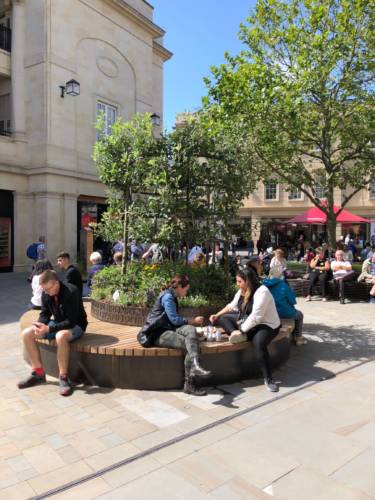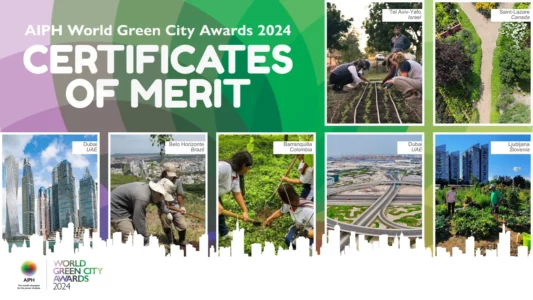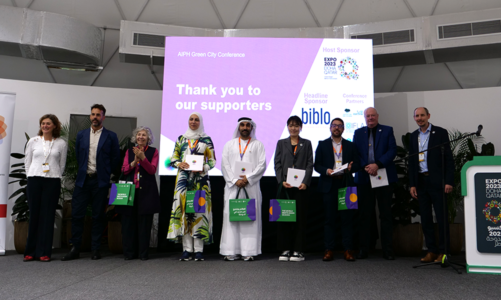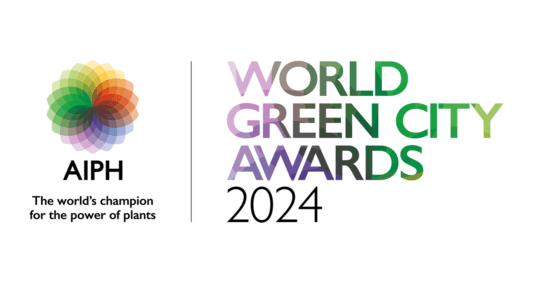Cities are complex systems connecting and integrating built infrastructure, water infrastructure, transport networks, communities, businesses, and designed and natural vegetation and urban wildlife. The green city principles explain the many benefits of including ‘living green’ in urban environments, and case studies illustrate how these principles are successfully put into practice.
This section presents short reports that context cross-disciplinary relevance to illustrate the importance of horticulture to other sectors. This extends the audience of the guidelines beyond the horticultural industry, and positions ‘living green’ as an essential part of all aspects of city planning and development.
AIPH 2020 Green City Guidelines can be used to deliver best practice advice to the construction industry to support Green Building/Zero Carbon development.
The inclusion of designed and natural vegetation around a building delivers quantifiable energy savings. The case study of Bosco Verticale reports that the green “second skin” of plants absorbs about 19.000 kg/year of carbon dioxide. It shields its residents from noise pollution and filters fine particulates from car traffic. It also reduces energy consumption due to increased insulation against outside temperatures and shading. This keeps the building cooler during summer – a reduction of nearly three Celsius degrees – and warmer during winter, reducing the need for active cooling and heating of internal spaces. One study placed the approximate yearly energy consumption reduction from this feature alone at 7.5%.
Urban electricity demand can increase by 2% for every 0.6C increase in summer temperature. Based on current warming projections, energy demand for electric cooling systems could increase by 10-20% by 2050.
Offices that have plants in and around the building are proven to enhance the performance of office workers. Neurological and physiological studies are revealing quantifiable benefits of biophilic design. Including plants into office design and décor can lower tension and anxiety levels by 37%, reduce feelings of anger by 44%, and reduce fatigue by 38%. Loss of productivity costs are 112 times greater than energy costs in the workplace, which translates employee well-being into cost savings. Better still than having plants in the office are views of nature from the office desk. Seeing movement in nature stimulates feelings of engagement with nature, and it is this dynamic interaction that provokes the optimal physiological responses that are the core of biophilia.
There are specific elements of the AIPH 2020 Green City Guidelines that protect and enhance Biodiversity in urban environments.
Figures often quoted are that by 2050 68% of the world’s population will live in cities. In order to accommodate this, programmes focus on city planning that ensures an equitable quality of life for all citizens. What is too commonly left off the agenda is that this increase in urban population will require expansion of the urban footprint, with estimates that cities may cover 3 x as much area by 2030 in comparison with 2000. What is of concern is that this expansion is into biodiversity hotspots, with almost 400 cities facing imminent conflict between urban expansion and biodiversity. Countries projected to lose the most natural habitat due to urban expansion are The United States, Brazil, Nigeria, and China.
If we consider biodiversity as the diversity within species, between species, and within ecosystems, and we think of cities as an urban ecosystem, we can start to define the role of cities in supporting biodiversity and how the extent and character of vegetation defines this success.
The green façade of Bosco Verticale includes a wide range of ornamental, arboricultural, maintenance, and eco-physiological considerations. Ornamental factors included height, density and texture of canopy, duration of foliage, significance and duration of blooming and autumn colour. The type of root system was also critical: it had to be suitable for cultivation in containers. The proposed species were further screened for their resistance to cold and wind, solar exposure, their watering needs, resistance to pollution, disease and pests, tolerance of drought and soil compaction, and ease of transplanting. This mix of vegetation types and species is very effective at promoting biodiversity: its 60 varieties of trees and 94 varieties of plant provide a home for an estimated 1,600 birds and butterflies. To help protect the vegetation against pests, 1,200 ladybirds were released across the planters of the buildings.
The Green City principles can be adapted to include edible plants in Urban Agriculture for both commercial and community purposes. The Food and Agriculture Organization (FAO) estimates that more than 800 million people engage in urban agriculture producing more than 15% of the world’s food.
The capacity for food production in cities is broad, and the benefits are multiple. Urban agriculture impacts on urban issues such as transport, health, land use, waste management, education, and community cohesion. Within cities, private land may be used for backyard vegetable gardens, with larger-scale public-private collaborative activity including community gardens, container gardening, and balcony gardening. Extending the capacity to the peri-urban fringe brings in additional sectors, such as community farms, small-plot intensive farming, urban orchards, and small livestock rearing.
Open or vacant land in cities has the potential to be planted and contribute the benefits of living green. This land could be transformed to sports facilities, parks, or gardens. Parks and gardens are commonly thought to be purely ornamental space, though the capacity for these to be productive and serve multiple purposes is being investigated. Food security, waste and food miles are all concerns as authorities consider the challenges of feeding an expanding population with diminishing resources.
Community gardening is one way for cities to become partially self-sufficient. The benefits of this are reduced food miles, food security in times of disrupted supply chains, and increasing the area of greening in cities.
A study in Sheffield, UK, (population of almost ¾ million) investigated the area that was available for urban agriculture, including both soil-based horticulture and soil-free controlled-environment horticulture on flat roofs. Existing land allocated to allotments has the capacity to produce fruit and vegetables for 3% of Sheffield’s population. Converting 10% of domestic garden space and 10% of other land suitable for fruit and vegetable production could produce food for a further 12% of the population. Converting all domestic garden space and other potential sites to food production has the potential to feed 122% of the population.
Climate, city infrastructure, population size, and resources all affect a city’s capacity to include urban agriculture. If all of the available land in New York City was converted to food production, it would only feed 2% of the population.
Vertical farms are limited to the crops they can grow. Trials in the UAE indicate that a reasonable range, including rice can be produced. Local production, however, focuses on herbs and greens, with fresh salad being a key cultural part of every meal. Vertical farms promote clean, traceable, pesticide-free production, enabling 6 hours from farm to kitchen.
The guidelines contribute to evidence-based integration of the Green City principles into transport infrastructure.
Efforts to reduce emissions that contribute to air pollution aim at reducing motorised transport in cities, and promoting active transport. Walking and cycling are far more attractive options when they are safe, visually pleasing, shielded from noise and air pollutants, separated from potentially dangerous motorised transport, and comfortable. Trees and vegetation provide many of these features. In addition, there is substantial evidence that greening and nature slows traffic speeds and reduces crime.
In Mexico a bill that was passed to reduce emissions and support sustainable development included mass transport systems and improved infrastructure for pedestrians and bicycles. This highlights the importance of sustainable transport as a climate change mitigation strategy. The World Health Organisation (WHO) reports that levels of physical activity are strongly determined by the physical environment.
In London, clean air routes designated in the city centre take pedestrians along streets that have lower air pollution. Monitoring reveals that clean air routes have between 30% and 60% lower concentration of air pollutants than more heavily used streets. Part of the lower air pollution is due to lower traffic use, and part is due to trees and vegetation along clean air routes. Planning processes are in development to increase signposting, on -street signals, greening, lighting, and urban realm improvements
The case study on the Chicago 606 describes how the Bloomingdale line was identified in the late nineties as an opportunity for creating a bike friendly off-road commuter route, intersecting with five bus lines and six surface bike paths, while also providing easy connection to Chicago’s ‘elevated’ transit system and to the region’s commuter rail link (Metra). Unlike other elevated rail parks that preceded it, such as New York’s High Line or Paris’ Promenade Plantée (neither of which allow cyclists), transit was part of the plans for The 606 from the beginning. Mile markers are set in the jogging path near specific trees fitted with barcodes, making it easier to locate and return to any given specimen for monitoring.
Between 2016 and 2019, The 606 attracted between 1.2 and 1.3 million visitors every year, primarily families, joggers, walkers and commuters. Most people who use the trail live near it. This is largely down to location and context, as The 606 runs through highly residential neighbourhoods. Design unarguably also plays an important role, as the elevated park provides amenities for commuters and recreational users alike. While accessibility is facilitated by the low height of the structure, it was further enhanced with good ground-level integration through six ‘spill over’ parks created alongside access points or through refurbishment of pre-existing open spaces.
The United Nations Sustainable Development Goals, the UN SDGs, are the reference point for many cities and organisations against which they commit and measure their sustainability. The UN SDGs that relate to the work of AIPH arise from the strength of our international member network, the AIPH International Expos, and particularly our activities in the Green City programme. This section describes the contribution that horticulture makes to achieving SDGs 3, 4, 6, 11, 13, and 15.
“The Sustainable Development Goals are the blueprint to achieve a better and more sustainable future for all. They address the global challenges we face, including those related to poverty, inequality, climate change, environmental degradation, peace and justice. The 17 Goals are all interconnected, and, in order to leave no one behind, it is important that we achieve them all by 2030.”
SDG 3: Good Health and Well-being.
Plants provide many health benefits, and relate to the SDGs when health is considered as more than the absence of disease. There is substantial quantifiable evidence of the well-being benefits of plants, demonstrating the role they have in recovery from ill health, and in positive mood that reduces the likelihood of stress-related illness.
SDG 4: Education
The AIPH 2020 Green City Guidelines serves the global horticultural sector though knowledge sharing. Promotion of the guidelines through other AIPH events, and networks with members facilitates exchange of information and shared learning from experience. Deliberate learning is afforded through AIPH publications and social media posts for promotion. AIPH owns the industry magazine FloraCulture International which, through a bi-monthly publication, brings the latest news and events in sustainable horticulture to 142 countries. AIPH has ambitions to develop online learning programmes that present the Green City principles described in the Green City Guidelines in a series of lessons and webinars to extend the reach of this informative publication.
SDG 6: Clean water and sanitation
Plants have a very clear role in filtering water. In natural landscapes, catchment management considers and maintains vegetation and topography to maximise water capture and control quality. In cities, water runoff from paved surfaces carries dirt and particulate pollution into stormwater drains and open waterways and reservoirs. Sustainable urban drainage systems in the built environment use the water retention and water filtering capacities of plants to manage storm water run-off and reduce flooding. Flooding events place pressure on engineered/ piped water management in cities, increasing the risk of their failure which can result in urban and sewer pollutants spilling into natural waterways. The ability of plants to temporarily retain water on their leaf surfaces slows down run-off, reducing pressure on conventional piped drainage systems.
SDG 11: Sustainable Cities and Communities
Sustainable urban development ensures that the needs of city dwellers are satisfied without negatively impacting on the environment in the short or long term.
Including living green in urban policy, planning and development provides solutions to many urban problems, and contributes to a liveable city for all. The AIPH 2020 Green City Guidelines educate and inform a wide readership, and illustrate the benefits of living green in creating sustainable and resilient cities and communities.
SDG 13: Climate Action
These guidelines describe initiatives in place and in development to improve awareness of the need for climate action across all ecosystem typologies and, through this awareness, to deliver effective information of the role that living green can play in addressing adaptation strategies that run parallel with mitigation strategies. These initiatives and case studies illustrate the power of plants in contributing to climate action and provide guidance on practical implementation.
SDG 15: Life on Land
A well planned and managed city environment that includes vegetation and nature operates as an effective ecosystem. In some cities there may be space for ‘rewilding’ to encourage semi-natural ecosystems to flourish. Most cities, however, are disturbed and unnatural habitats, yet this does not diminish the role that vegetation in cities can play in conservation.
Designed landscapes contribute to urban biodiversity by providing mixed habitat. Many reports focus on invertebrates, and there are a wide range of urban planting situations in which invertebrates flourish. Flower-rich perennial plantings provide a long season of flowers for pollinators. Plant life in cities supports a wide range of biodiversity, depending on plant choices, spatial connectivity, climate, and management strategies.


















